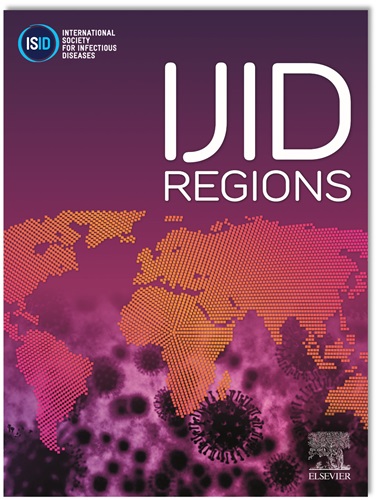Genotypic diversity and antimicrobial resistance determinants in Salmonella Typhi isolated from children living in informal settlements in Nairobi, Kenya
IF 4.8
2区 医学
Q1 INFECTIOUS DISEASES
引用次数: 0
Abstract
Introduction
Whole genome sequencing (WGS) is an important tool for disease diagnostics and identification of circulating multi-drug resistant (MDR) genotypes of enteric pathogens globally. In typhoid-endemic regions, WGS of Salmonella Typhi (S. Typhi) has identified haplotype 58 (H58) as one of the dominant MDR haplogroups. This case-control study reports on antimicrobial resistance (AMR) genes and genotypic diversity of S. Typhi from sick and asymptomatic children in Mukuru and Kibera informal settlements in Nairobi County.
Methods
From 2013 to 2018, children ≤ 16 years presenting to 4 health facilities in Nairobi County were recruited if they had a fever; ≥380C with or without diarrhea. Asymptomatic individuals (controls) who reported to the facilities for vaccinations and with non-typhoid-related symptoms were also recruited. Both groups provided stool samples that were subjected to culture and antimicrobial susceptibility testing for phenotypic analysis of AMR. S. Typhi isolates that showed resistance to ampicillin, co-trimoxazole, and chloramphenicol were considered as MDR and subjected to WGS. Deoxyribonucleic acid (DNA) of 90 S. Typhi isolates (44 from sick and 46 from asymptomatic individuals) was extracted for WGS. Sequencing was done using the Illumina Nextseq2000 platform. The generated raw reads were de novo assembled and pathogen-watch was used for analysis.
Results
Of the sequenced isolates, 60(69%) were confirmed to be S. Typhi. All of the S. Typhi belonged to the sequence Type 1 and genotype 4.3.1 (Haplotype 58). Out of the 60 S. Typhi strains 40(67%) were found to have plasmids, out of which 38(95%) had the IncHI1A/IncHI1B (R27) plasmids. The distribution of S. Typhi in sick and asymptomatic individuals was almost equal at 31(51%) and 30(49%). The 60 S. Typhi isolates were observed to have AMR determinants of 6 antibiotics with ampicillin (bla TEM-1D) as the most common, observed in 59 (98%) of the isolates. Point mutations conferring reduced susceptibility to quinolones were detected in 42 (70%) of S. Typhi isolates, 14(33%) gyrA_S83Y, and 28/42 (67%) gyrB_S464F.
Discussion
This study reports all MDR S. Typhi sequenced to belong to sequence Type 1. Genotype 4.3.1 (H58) was observed as the most dominant S. Typhi genotype among the symptomatic and asymptomatic individuals. Haplotype 58 is responsible for the spread of MDR phenotypes that carry on IncHI1 plasmids.
Conclusion
Circulation of H58 S. Typhi genotypes in Mukuru and Kibera informal settlements especially among asymptomatic individuals reiterates the need for mass vaccination as a control and prevention measure of Typhoid fever in urban informal settlements in Kenya.
从肯尼亚内罗毕非正式住区儿童中分离出的伤寒沙门氏菌的基因型多样性和抗微生物药物耐药性决定因素
全基因组测序(WGS)是疾病诊断和鉴定全球肠道病原体循环多药耐药(MDR)基因型的重要工具。在伤寒流行地区,伤寒沙门氏菌WGS鉴定出58单倍型(H58)是耐多药单倍型的主要亚型之一。本病例对照研究报告了内罗毕县Mukuru和Kibera非正式住区患病和无症状儿童的伤寒沙门氏菌抗微生物药物耐药性(AMR)基因和基因型多样性。方法选取2013 - 2018年在内罗毕县4家卫生机构就诊的≤16岁发热儿童为研究对象;≥380C,伴或不伴腹泻。还招募了向设施报告接种疫苗且无伤寒相关症状的无症状个体(对照组)。两组均提供粪便样本,进行培养和抗菌药敏试验,以进行AMR表型分析。对氨苄西林、复方新诺明和氯霉素耐药的伤寒沙门氏菌被认为是耐多药,并进行WGS。提取90株伤寒沙门氏菌(44株为患病株,46株为无症状株)的脱氧核糖核酸(DNA)进行WGS分析。测序使用Illumina Nextseq2000平台。生成的原始reads重新组装,并使用病原体观察进行分析。结果60株(69%)为伤寒沙门氏菌。所有伤寒沙门氏菌均为1型序列和4.3.1基因型(单倍型58)。60株伤寒沙门氏菌中有40株(67%)含有质粒,其中38株(95%)含有IncHI1A/IncHI1B (R27)质粒。伤寒沙门氏菌在患病和无症状个体中的分布几乎相等,分别为31例(51%)和30例(49%)。60株伤寒沙门氏菌分离株具有6种抗生素的AMR决定因子,其中氨苄西林(bla TEM-1D)最为常见,59株(98%)存在AMR决定因子。在42例(70%)伤寒沙门氏菌分离株、14例(33%)gyrA_S83Y和28/42例(67%)gyrB_S464F中检测到对喹诺酮类药物敏感性降低的点突变。本研究报告所有耐多药伤寒沙门氏菌序列均属于1型序列。在有症状和无症状个体中,基因型4.3.1 (H58)为最显性的伤寒沙门氏菌基因型。单倍型58负责携带IncHI1质粒的MDR表型的传播。结论在穆库鲁和基贝拉非正规住区中,特别是在无症状人群中存在H58伤寒沙门氏菌基因型的流行,再次表明有必要在肯尼亚城市非正规住区进行大规模疫苗接种,作为伤寒控制和预防措施。
本文章由计算机程序翻译,如有差异,请以英文原文为准。
求助全文
约1分钟内获得全文
求助全文
来源期刊
CiteScore
18.90
自引率
2.40%
发文量
1020
审稿时长
30 days
期刊介绍:
International Journal of Infectious Diseases (IJID)
Publisher: International Society for Infectious Diseases
Publication Frequency: Monthly
Type: Peer-reviewed, Open Access
Scope:
Publishes original clinical and laboratory-based research.
Reports clinical trials, reviews, and some case reports.
Focuses on epidemiology, clinical diagnosis, treatment, and control of infectious diseases.
Emphasizes diseases common in under-resourced countries.

 求助内容:
求助内容: 应助结果提醒方式:
应助结果提醒方式:


